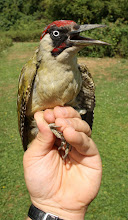I took over 1000 photographs of birds in Spain, so rather unsurprisingly, I've still got more to share with you. Don't worry, I won't be posting 1000 photographs as most of them have been or will be deleted. Here is a mix species I saw less than a handful of times and a couple that were much more common.
Above: A Melodious Warbler (Zarcero común). This was my first time seeing this species and was glad I got a photograph as identification of warblers can be tricky.
Above: Another and very obliging Melodious Warbler (Zarcero común) at Saucedilla. I only saw these 2 during the whole holiday.
Above: A Black-Kite (Milano negro). This species was very common across the region, by far outnumbering Red Kites (Milano real). One day, driving past a house/farm near Trujillo with goats in the back yard, I counted more than 20 circling very low down - perhaps they were waiting for a goat to keel over!
Above: A Black-winged Kite (Elanio azul). Definitely on the 'must see' list. I was very happy when, whilst driving along, I shouted "Black-winged kite, STOP THE CAR!" Two were on a telegraph pole & line.
On the second to last day, we saw another near Saucedilla. Observing it, I noticed it can hover almost like a kestrel and it has a glide resembling that of a harrier.
Above: Azure-winged Magpie (Rabilargo). These were very common across the region. A highly mobile species that always stayed at a distance.
Above: Booted Eagle (Águila calzada). The lighting wasn't good but inbetween rain showers, this bird flew past us. If you look at the photograph carefully, you will see the diagnostic white patches (also known as 'landing lights') either side of the neck. Only 2 or 3 were seen during the holiday.
Before going to Spain, I read a couple of reports that said migration and bird numbers were significantly down compared to normal, strong winds and unfavourable wind directions meaning migratory birds were being held up or being diverted elsewhere. Since coming back, I spoke to someone who was there at the same time as me (and who had been 3 years previously) and he confirmed numbers were significantly down. I certainly can't complain as it was fantastic to see over 100 species, a quarter of which I'd not seen before. I may return in future and if it's a good year, it should be well worth going again!

